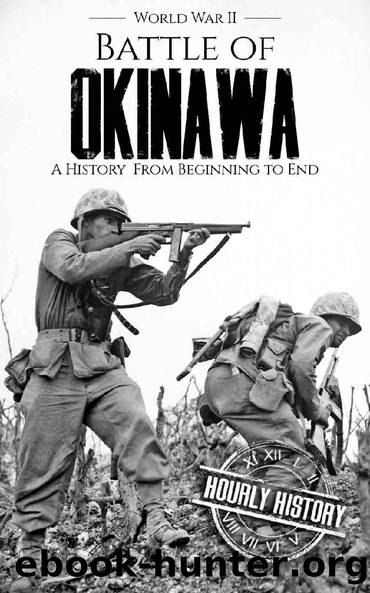Battle of Okinawa - World War II: A History from Beginning to End (World War 2 Battles Book 13) by Hourly History

Author:Hourly History [History, Hourly]
Language: eng
Format: epub
Published: 2019-09-02T00:00:00+00:00
Chapter Five
A Fight to the Death
âCorpses litter the gray, muddy landscape. There are numerous severed arms and legs. And an occasional head. . . . Some of the corpses seem to be grinning. The flesh has rotted away from the skull and the teeth are bared. I am afraid that if I stare, one of these grinning dead might ask: âDonât you belong with us?ââ
âElvis Lane
The Marines were having just as gut-wrenching a time in their battle as was the Army, both branches of the military united in the struggle to overcome Japanese resistance on the island of Okinawa. For the Marines who were fighting at Dakeshi Ridge, Wana Ridge, Wana Draw, and Sugar Loaf, an advance of inches would be driven back by Japanese machine guns. One soldier recalled that there was never a moment when fear wasnât present. For three days, the Marines mounted cover fire, while one of them would crawl in the direction of a cave or a machine-gun nest and throw a grenade or a satchel charge. But finally, on May 14, Dakeshi Ridge fell.
Wana Draw and Wana Ridge took longer. The Marines entered Wana Draw on May 14 and were met with fire so intense from so many positions that they could not advance. When a Marine tank crew sent six phosphorus smoke cells into one cave entrance, they were astounded to see smoking coming out of more than thirty other entrances.
The incessant shelling from both sides, combined with heavy rains, transformed Wana Ridge and Wana Draw into landscapes denuded of any beauty. Bodies of fallen Marines and Japanese soldiers often had to be left where they lay; retrieving them would only expose more men to the never-ending artillery barrages. The bodies were decaying and maggots were devouring the rotting flesh. Private Sledge explained, âIt is too preposterous to think that men could actually live and fight for days and nights on end under such terrible conditions and not be driven insane.â
The Marines suffered not only from the Japanese gunfire but also from the conditions brought about by the cold rains, as their skin shriveled and whitened due to exposure. They also suffered emotionally from combat fatigue. On the other side, Ushijima, despite the courage of his men, lacked supplies and reinforcements. At the end of May, he pulled his forces from Wana Draw and the Shuri Line. The Marines promptly went in.
Sugar Loaf Hill remained yet another challenge to be conquered at a high cost. Defended by 2,000 Japanese soldiers lying in wait, the hill had minimal foliage. To the south and southwest were Horseshoe Hill and Half Moon Hill, which made Sugar Loaf an arrowhead pointed from Shuri toward the Marines. On May 12, three platoons attempted to mount the slopes of Sugar Loaf Hill, but two of the three platoons were struck by the Japanese. The third platoon charged the crest, but after going 100 yards, 28 out of 40 men had fallen, and those who remained had no choice but to pull back.
Download
This site does not store any files on its server. We only index and link to content provided by other sites. Please contact the content providers to delete copyright contents if any and email us, we'll remove relevant links or contents immediately.
The Light of Days by Judy Batalion(1063)
First Platoon: A Story of Modern War in the Age of Identity Dominance by Annie Jacobsen(902)
Stalin's War: A New History of World War II by Sean McMeekin(861)
The Pacific War 1941-1943 by James Holland(803)
Walk in My Combat Boots by James Patterson(764)
The American War in Afghanistan by Carter Malkasian(741)
Victory's Price (Star Wars) by Alexander Freed(734)
The Vietnam War: An Intimate History by Geoffrey C. Ward & Ken Burns(721)
Blood and Ruins: The Great Imperial War, 1931-1945 by Richard Overy(686)
Operation Pedestal by Max Hastings(683)
Concepts of Space by Jammer Max;(667)
Cold War (Alexander King Book 2) by Bradley Wright(660)
Extreme Fitness by Chris McNab(654)
The Madman Theory by Jim Sciutto(651)
Flying Tiger by Samson Jack(633)
World War II Infantry Fire Support Tactics by Gordon L. Rottman(612)
Pathfinders by AL-KHALILI JIM(611)
Panzerkrieg by Mike Syron(599)
Bismarck by Jean-Paul Bled(585)
